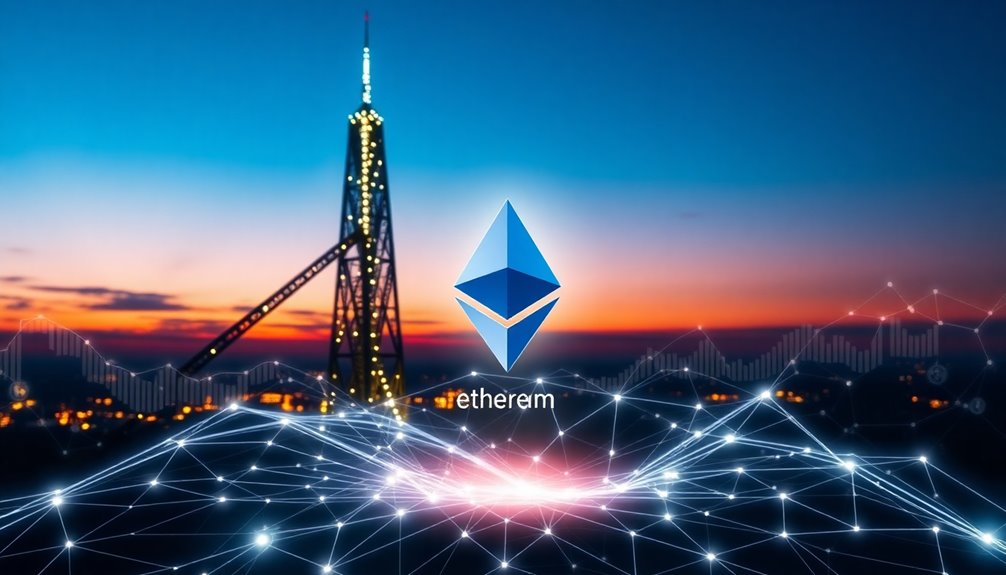A DeFi protocol is a set of rules and software that enables you to conduct financial transactions directly on the blockchain, completely bypassing traditional intermediaries. This decentralized approach opens up access to everyone with an internet connection and significantly lowers transaction costs. Smart contracts automate processes to ensure efficiency and transparency, making it easier for you to lend, borrow, or trade. With over $176 billion locked in assets, these protocols are reshaping the financial landscape. If you're curious about how DeFi can affect your investment strategies, there's a lot more to uncover about its potential.
Key Takeaways
- A DeFi protocol is a set of smart contracts on a blockchain that facilitates decentralized financial services without intermediaries.
- These protocols enable peer-to-peer transactions, enhancing accessibility to financial services for anyone with internet access.
- Key features include transparency, as all transactions are recorded on public blockchains, and automation through self-executing smart contracts.
- DeFi protocols can replicate traditional financial services like lending and borrowing while aiming to reduce costs and improve efficiency.
- Regulatory compliance remains a challenge due to the pseudonymous nature of transactions and the lack of centralized governance.
Core Principles of DeFi

As you explore the world of decentralized finance (DeFi), you'll find that its core principles fundamentally reshape how financial services operate.
Decentralization removes intermediaries like banks, allowing you to engage in peer-to-peer financial transactions directly. Transparency is crucial, as every transaction is recorded on a public blockchain, enabling you to verify and audit protocols seamlessly.
Accessibility is another key aspect; anyone with internet access can participate without the barriers of traditional banking systems. The open-source nature of DeFi fosters collaboration, inviting developers to enhance protocols through community-driven governance mechanisms.
Smart contracts automate processes and enforce agreements, boosting efficiency while lowering costs associated with conventional financial services. Embracing these principles can transform your financial interactions.
Overview of Defi Principles

Understanding the principles of decentralized finance (DeFi) is essential for anyone looking to navigate this innovative financial landscape.
At its core, DeFi leverages smart contracts on blockchain networks, primarily Ethereum, to automate and enforce financial transactions without intermediaries. This decentralized approach ensures that no single entity controls the system, promoting transparency where you can verify every transaction.
Accessibility is another key principle, allowing anyone with internet access to participate in financial services. Popular applications, like decentralized exchanges and lending platforms, aim to replicate traditional financial services while enhancing financial inclusion and reducing fees.
Smart Contracts Automate Transactions

Smart contracts revolutionize financial transactions by automating processes that traditionally require human intervention.
These self-executing contracts, deployed on blockchain networks like Ethereum, ensure security and transparency by directly embedding the terms of agreements in code.
In the decentralized financial (DeFi) ecosystem, smart contracts enable a variety of financial applications, such as lending and borrowing platforms, by eliminating intermediaries and reducing the potential for errors or fraud.
This automation significantly lowers transaction costs and speeds up processing times, making financial transactions more efficient.
As of 2023, the adoption of smart contracts has contributed to a total value locked (TVL) in DeFi assets exceeding $176 billion, underscoring their vital role in modern finance.
Pros and Cons Analysis

While DeFi protocols bring significant benefits, they also come with notable risks. Operating on decentralized networks, these systems allow you to engage in financial transactions like lending and trading without intermediaries, cutting down transaction costs.
The transparency of open-source DeFi protocols fosters innovation; however, smart contracts can be vulnerable, leading to potential exploits. You need to be aware of the risks involved, particularly regarding security measures and market volatility, which can impact asset values.
While yield farming offers high returns, the lack of regulatory oversight raises concerns about fraud and market manipulation. Balancing the advantages with these risks is crucial for anyone looking to navigate the DeFi landscape effectively.
Protocol Performance Metrics

To evaluate the effectiveness of DeFi protocols, you'll want to focus on several key performance metrics.
Total Value Locked (TVL) is crucial, as it indicates user trust and the protocol's popularity, with DeFi assets surpassing $176 billion in 2021.
Next, consider the annual percentage yield (APY) offered by lending protocols, which can range significantly, reflecting profitability for liquidity providers.
Transaction volume is another vital metric; successful platforms like Uniswap handle billions in trades daily, highlighting user engagement.
Additionally, track active users and wallet addresses to assess adoption rates.
Finally, governance participation rates reveal community involvement in decentralized decision-making processes, showcasing how engaged users are in shaping the protocol's future.
Regulatory Compliance Issues

As DeFi protocols continue to gain traction, they often find themselves navigating a complex landscape of regulatory compliance issues. By eliminating intermediaries, these protocols bypass traditional financial systems, complicating adherence to existing laws.
With many projects embracing permissionless and pseudonymous designs, meeting anti-money laundering (AML) and know-your-customer (KYC) requirements becomes challenging. The decentralized nature of DeFi makes it difficult for regulatory bodies to enforce rules, as governance lacks a single entity responsible for oversight.
Increasing scrutiny on hybrid finance (HyFi) models highlights the urgent need for clearer compliance measures. As the DeFi market matures, there's a growing emphasis on creating regulatory frameworks that balance innovation with accountability, aiming to protect users while fostering the growth of financial technology.
Emerging Layer 2 Solutions

Emerging Layer 2 solutions are revolutionizing the DeFi landscape by significantly enhancing scalability and efficiency in blockchain networks.
These solutions, like Arbitrum and Polygon, enable faster transaction processing and reduced fees by handling transactions off the main blockchain.
With the total value locked in Layer 2 protocols exceeding $10 billion as of October 2023, interest in these emerging networks is skyrocketing.
By utilizing techniques like Optimistic Rollups and zk-Rollups, they increase throughput while ensuring security.
This integration with existing DeFi protocols boosts the user experience, making decentralized applications more accessible.
As transaction fees drop and latency decreases, you're likely to see broader adoption of these innovative technologies, paving the way for a more efficient financial ecosystem.
Diversify Asset Allocations Strategically

Layer 2 solutions have made it easier than ever to engage with DeFi protocols, but it's just as important to think about how you allocate your assets within these networks.
To diversify asset allocations effectively, consider utilizing liquidity pools on platforms like Balancer, allowing you to tailor asset ratios for optimized returns. Incorporating stablecoins in your portfolio can act as a safeguard against market volatility while still enabling yield generation through lending or liquidity provision.
Additionally, yield farming often requires spreading assets across various protocols, enhancing risk management and boosting returns. By analyzing performance across diverse DeFi assets, you can construct a well-balanced portfolio that mitigates risks associated with the fluctuating crypto market and aligns with your investment strategies and asset management goals.
Frequently Asked Questions
What Is an Example of a Defi?
An example of a DeFi project you might explore is Uniswap.
It's a decentralized exchange where you can swap cryptocurrencies directly, without relying on intermediaries.
By using its liquidity pools, you can provide your assets and earn trading fees.
With the introduction of concentrated liquidity in Uniswap V3, you have even more control over your investments, allowing you to maximize your capital efficiency and potential earnings.
It's a popular choice in the DeFi space!
What Is the Best Defi Protocol?
Choosing the best DeFi protocol depends on your needs.
If you're looking for decentralized lending and borrowing, Aave's features might suit you well.
For trading, Uniswap offers significant liquidity.
If stability's your concern, MakerDAO's DAI stablecoin is a solid option.
Want to maximize returns? Yearn Finance automates yield strategies.
For stablecoin swaps, Curve Finance excels with low slippage.
Evaluate these options based on what you aim to achieve in the DeFi space.
What Is Defi and How It Works?
DeFi, or Decentralized Finance, lets you engage in financial activities directly with others, cutting out intermediaries like banks.
It works through smart contracts, which automatically execute transactions based on coded terms. This system offers services like lending, trading, and earning yields, all without a central authority.
How Do Defi Protocols Make Money?
When it comes to making money, DeFi protocols have got it all figured out. They charge transaction fees for trades, lend out assets at higher interest rates, and reward liquidity providers with governance tokens.
Conclusion
In the dynamic world of DeFi, where over $100 billion is locked in various protocols, you're witnessing a financial revolution. By leveraging smart contracts and emerging solutions, you can navigate this landscape with strategic asset allocation. While the potential rewards are enticing, staying informed about regulatory compliance is crucial. As you explore DeFi, remember that every decision counts in shaping your financial future—seize the opportunity and embrace the innovation that's transforming how we think about money.









